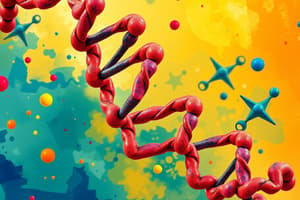Podcast
Questions and Answers
What are the monomers of proteins?
What are the monomers of proteins?
- Amino Acids (correct)
- Nucleotides
- Monosaccharides
- Fatty Acids
Name two examples of proteins.
Name two examples of proteins.
Hemoglobin, Insulin
Proteins are bonded by ______.
Proteins are bonded by ______.
peptide bonds
List one function of proteins.
List one function of proteins.
What is the monomer of carbohydrates?
What is the monomer of carbohydrates?
Give an example of a disaccharide.
Give an example of a disaccharide.
What is one function of carbohydrates?
What is one function of carbohydrates?
What are the monomers of lipids?
What are the monomers of lipids?
Name an example of lipids.
Name an example of lipids.
Provide one function of lipids.
Provide one function of lipids.
What are the monomers of nucleic acids?
What are the monomers of nucleic acids?
Name an example of nucleic acids.
Name an example of nucleic acids.
What is one function of nucleic acids?
What is one function of nucleic acids?
Flashcards are hidden until you start studying
Study Notes
Proteins - Monomer
- Composed of amino acids; there are 20 distinct types.
- Amino acids are linked by peptide bonds.
- Synthesized by ribosomes within the cell.
Proteins - Examples
- Notable proteins include hemoglobin, insulin, keratin, collagen, actins, myosins.
- Enzymes function as biological catalysts; antibodies are vital for immune response.
- Blood clotting proteins play a crucial role in wound healing.
Proteins - Functions
- Hemoglobin carries oxygen in red blood cells.
- Insulin facilitates the transport of sugar into cells.
- Structural role in muscles and tissues; acts as catalysts for biochemical reactions.
- Essential for immune function and stopping bleeding.
Carbohydrates - Monomer
- The basic unit is monosaccharide, simple sugars like glucose (C₆H₁₂O₆), galactose, and fructose.
- Provide a primary energy source for the body.
Carbohydrates - Examples
- Include ribose and deoxyribose in RNA and DNA respectively.
- Disaccharides like sucrose, maltose, and lactose are formed from two monosaccharides.
- Polysaccharides include starch, glycogen, cellulose, and chitin for energy storage and structural functions.
Carbohydrates - Functions
- Sugars play a role in heredity material.
- Serve as energy storage in plants (starch) and animals (glycogen).
- Provide structure in plants (cellulose) and in the exoskeletons of insects.
Lipids - Monomer
- Composed of one glycerol and fatty acids.
- Saturated fatty acids are linked to adverse heart health; unsaturated fatty acids are beneficial.
Lipids - Examples
- Fats are solid at room temperature; oils are liquid.
- Includes waxes, phospholipids, steroids, and cholesterol.
- Function as energy storers, hormones, and cellular components.
Lipids - Functions
- Provide cushioning for organs and waterproofing for skin and feathers.
- Insulate the body and store more energy per gram compared to other biomolecules.
- Integral components of cell membranes; involved in hormone production.
Nucleic Acids - Monomer
- Made up of nucleotides, which consist of a sugar, phosphate group, and nitrogenous base.
Nucleic Acids - Examples
- Two primary types are DNA (deoxyribonucleic acid) and RNA (ribonucleic acid).
Nucleic Acids - Functions
- Serve as heredity material, crucial for genetic information storage and transfer.
- Play a key role in the synthesis of proteins.
Studying That Suits You
Use AI to generate personalized quizzes and flashcards to suit your learning preferences.




